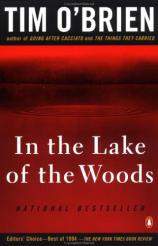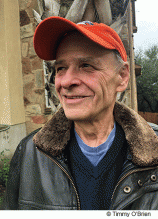About the Book
About the Book
In the Lake of the Woods

As Tim O'Brien gradually reveals in this haunting, morally vertiginous novel, there were too many reasons for Kathy to vanish. All of them are connected to her husband, John, an attractive if morally confused 40-year-old politician whose career has lately ended in a defeat so humiliating that it has driven the Wades to an isolated cabin in the Minnesota woods.
A long-buried secret has resurfaced to bury John alive; perhaps it has buried Kathy along with him. John's disgrace originated in "a place with secret trapdoors and tunnels and underground chambers populated by various spooks and goblins, a place where magic was everyone's hobby...a place where the air itself was both reality and illusion, where anything might instantly become anything else."
Its geographic epicenter is the village of Thuan Yen in Vietnam. It was there, eighteen years before, that John Wade was transformed from a boy with a gift for performing magic tricks (his platoon-mates knew him as "Sorcerer") into an entranced killer.
What happened at Thuan Yen was not fiction. The events that took place there were widely reported and documented in official U.S. Army hearings and are known today as the My Lai massacre. At the heart ofIn the Lake of the Woods is its brutal re-creation of this wound in John Wade's history and his country's. Because Wade was one of many killers, Tim O'Brien intersperses his narrative with the testimony of real figures like Lieutenant Rusty Calley and U.S. Army Investigator William V. Wilson--not to mention Presidents Richard Nixon and Woodrow Wilson. Just as John's and Kathy's associates--his mother and campaign manager, her sister and co-worker--try to decipher the events at Lake of the Woods, those historical witnesses posit partial explanations for America's mysteriously aligned obsessions with politics and violence.
Clausewitz observed that war is the continuation of politics by other means. Tim O'Brien suggests that politics, at least in its American variety, is a continuation of needs more basic and more terrible even than the need for power. The craving for love, he reminds us, can drive the human soul toward acts of desperation, deceit, and even violence.
For O'Brien, as for the unnamed investigator who is his narrator, all explanations are hypotheses rather than proofs. Beyond the mystery of Kathy's disappearance and John's role in it, and even beyond the mystery of My Lai, are other riddles: What predisposed John to become a murderer? What sort of magic enabled him to make his past vanish for twenty years, and what disappeared along with it? How could he love Kathy with such self-annihilating ferocity while keeping an essential part of himself hidden from her? Was Kathy a victim of John's deceptions or a participant in them? Is John an autonomous moral agent or another victim-of a bad childhood or a bad war or the murderous pastel sunlight of Vietnam? With In the Lake of the Woods, O'Brien has reinvented the novel as a magician's trick box equipped with an infinite number of false bottoms. Kathy's disappearance remains a "magnificent giving over to pure and absolute Mystery." John believes that "to know is to be disappointed. To understand is to be betrayed." This brave and troubling novel neither betrays nor disappoints, but brings the reader into a direct confrontation with the insoluble enigmas of history, character, and evil.
In the Lake of the Woods
- Publication Date: September 1, 1995
- Genres: Fiction
- Paperback: 320 pages
- Publisher: Penguin (Non-Classics)
- ISBN-10: 0140250948
- ISBN-13: 9780140250947








